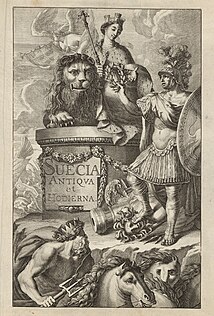
Fraktur is a calligraphic hand of the Latin alphabet and any of several blackletter typefaces derived from this hand. The blackletter lines are broken up; that is, their forms contain many angles when compared to the smooth curves of the Antiqua (common) typefaces modeled after antique Roman square capitals and Carolingian minuscule. From this, Fraktur is sometimes contrasted with the "Latin alphabet" in northern European texts, which is sometimes called the "German alphabet", simply being a typeface of the Latin alphabet. Similarly, the term "Fraktur" or "Gothic" is sometimes applied to all of the blackletter typefaces.

Suecia Antiqua et Hodierna is a collection of engravings collected by Erik Dahlbergh during the middle of the 17th century. Suecia Antiqua et Hodierna can be described as a grand vision of Sweden during its period as a great power. Dahlberg's direct source of inspiration was the topographical publications issued by the Swiss publisher Matthäus Merian. In 1661 Dahlberg was granted a royal privilege enabling him to realize his plans, which kept him occupied for a good decade, and a work that would not be printed until after his death. In its final state Suecia Antiqua et Hodierna comprised three volumes containing 353 plates.
Ars antiqua, also called ars veterum or ars vetus, is a term used by modern scholars to refer to the Medieval music of Europe during the High Middle Ages, between approximately 1170 and 1310. This covers the period of the Notre Dame school of polyphony, and the subsequent years which saw the early development of the motet, a highly varied choral musical composition. Usually the term "ars antiqua" is restricted to sacred (church) or polyphonic music, excluding the secular (non-religious) monophonic songs of the troubadours, and trouvères. However, sometimes the term "ars antiqua" is used more loosely to mean all European music of the thirteenth century, and from slightly before. The term ars antiqua is used in opposition to ars nova, which refers to the period of musical activity between approximately 1310 and 1375.

Antiqua ) is a style of typeface used to mimic styles of handwriting or calligraphy common during the 15th and 16th centuries. Letters are designed to flow and strokes connect together in a continuous fashion; in this way it is often contrasted with Fraktur-style typefaces where the individual strokes are broken apart. The two typefaces were used alongside each other in the germanophone world, with the Antiqua–Fraktur dispute often dividing along ideological or political lines. After the mid-20th century, Fraktur fell out of favor and Antiqua-based typefaces became the official standard.

Philipp Clüver was an Early Modern German geographer and historian.
Edwin Johnson (1842–1901) was an English historian, best known for his radical criticisms of Christian historiography.

The Antiqua–Fraktur dispute was a typographical dispute in 19th- and early 20th-century Germany.

Santa Maria Antiqua is a Roman Catholic Marian church in Rome, Italy, built in the 5th century in the Forum Romanum, and for a long time the monumental access to the Palatine imperial palaces.
Musica Antiqua Köln was an early music group that was founded in 1973 by Reinhard Goebel and fellow students from the Conservatory of Music in Cologne. Musica Antiqua Köln devoted itself largely to the performance of the music of the 17th and 18th centuries. The group recorded extensively for Archiv Produktion and received numerous awards, including the Grand Prix International du Disque, Gramophone Award, Diapason d’or, and Grammy nominations.

Orgyia antiqua, the rusty tussock moth or vapourer, is a moth in the family Erebidae.
Pro Cantione Antiqua of London (PCA) is a British choral group which was founded in 1968 by tenor James Griffett, counter-tenor Paul Esswood, and conductor and producer Mark Brown. Their first concert was at St Bartholomew's, Smithfield with Brian Brockless conducting but, from an early stage, they were closely associated with conductor and musicologist Bruno Turner. Arguably, they were the leading British performers of a cappella music, especially early music, prior to the founding of the Tallis Scholars.
Events from the year 1639 in Ireland.
Gavialosuchus is an extinct tomistomine from the early Miocene of Europe.

Thecachampsa is an extinct genus of tomistomine crocodylian. Fossils have been found from the eastern United States in deposits of late Oliogcene to Miocene age. Those named in the 19th century were distinguished primarily by the shape of their teeth, and have since been combined with T. antiqua. More recently erected species were reassigned from other tomistomine genera, although their assignment to Thecachampsa has since been questioned.
Phrissomini is a tribe of longhorn beetles of the Lamiinae subfamily. It was described by Thomson in 1860.
Echinovelleda is a genus of longhorn beetles of the subfamily Lamiinae, containing the following species:

Events from the year 1716 in Sweden

Events from the year 1666 in Sweden
Echinovelleda chinensis is a species of beetle in the family Cerambycidae. It was described by Stephan von Breuning in 1936. It is known from China.

Antykwa Półtawskiego is an antiqua typeface designed by Adam Półtawski from 1923 to 1928 specifically for the Polish language.











